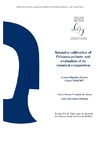Please use this identifier to cite or link to this item:
https://accedacris.ulpgc.es/jspui/handle/10553/74981
| Title: | Intensive cultivation of "Palmaria palmata" and evaluation of its chemical composition | Authors: | Figueira García, Laura | Director: | Gómez Pinchetti, Juan Luis Trindade De Abreu, María Helena |
UNESCO Clasification: | 241707 Algología (ficología) | Keywords: | Palmaria palmata Cultivation Productivity Chemical composition Fatty acids |
Issue Date: | 2017 | Abstract: | Seaweed based Integrated Multi-Trophic Aquaculture (IMTA) systems are being
designed to mitigate the environmental problems caused by several forms of fed
aquaculture. A seaweed cultivation system using 127 and 230 L tanks was used to
cultivate Palmaria palmata (Rhodophyta). Palmaria palmata is a cold temperate species
of the North Atlantic and North Pacific Oceans. In the present study Palmaria palmata
could grow throughout the entire course of the experiment and under all conditions tested.
The highest RGR value (3,13 % ± 0,40) was observed from Palmaria palmata cultivated
under a density of 1 kg m-2. Under winter conditions the productivity value reach the
maximal value of 26,89 ± 19,02 g(dw) m-2 week−1. The total lipid, protein, ash,
carbohydrates and individual fatty acid contents of Palmaria palmata were determined
(fatty acids by gas chromatography). Total lipid content ranged from 0,00389 ± 0,0003
to 0,00987 ± 0,00030 (% ± se). The most abundant fatty acids were C16:0, C18:0 and
C20:5. Ash content ranged from 14,5 ± 0,67 to 24,2 ± 0,86 (% ± se), protein content from
17,3 ± 0,05 to 24,8 ± 0,02 (% ± se) and carbohydrates from 55,52 to 67,56%. La Acuicultura Multi-Trófica Integrada (AMTI) está basada en algas para mitigar los problemas ambientales causados por los procesos desarrollados en la acuicultura moderna. Se utilizó un sistema de cultivo de algas utilizando tanques de 127 y 230 L para cultivar Palmaria palmata (Rhodophyta). Palmaria palmata es una especie de temperatura fría del Atlántico Norte y del Océano Pacífico Norte. En este estudio, Palmaria palmata fue capaz de crecer a lo largo de todo el experimento y bajo todas las condiciones testadas. El mayor valor de la tasa relativa de crecimiento (3,13% ± 0,40) se observó a partir de Palmaria palmata cultivada bajo una densidad de 1 kg m-2. En condiciones invernales, el valor de productividad alcanza el valor máximo de 26.89 ± 19,02 g (peso seco) m-2 semana-1. Se determinaron los contenidos totales de lípidos, proteínas, cenizas, carbohidratos y ácidos grasos individuales. (Ácidos grasos mediante cromatografía de gases). El contenido total de lípidos osciló entre 0,00389 ± 0,0003 y 0,00987 ± 0,00030 (% ± se). Los ácidos grasos más abundantes fueron C16:0, C18:0 y C20:5. El contenido de cenizas varió de 14,5 ± 0,67 a 24,2 ± 0,86 (% ± se), contenido de proteína de 17,3 ± 0,05 a 24,8 ± 0,02 (% ± se) y carbohidratos de 55,52 a 67,56%. |
Department: | Departamento de Biología | Faculty: | Facultad de Ciencias del Mar | Degree: | Grado en Ciencias del Mar | URI: | https://accedacris.ulpgc.es/handle/10553/74981 |
| Appears in Collections: | Trabajo final de grado Restringido ULPGC |
En el caso de que no encuentre el documento puede ser debido a que el centro o las/os autoras/es no autorizan su publicación. Si tiene verdadero interés en el contenido del mismo, puede dirigirse al director/a o directores/as del trabajo cuyos datos encontrará más arriba.
Show full item recordPage view(s)
273
checked on Oct 31, 2024
Download(s)
382
checked on Oct 31, 2024
Google ScholarTM
Check
Share
Export metadata
Items in accedaCRIS are protected by copyright, with all rights reserved, unless otherwise indicated.
